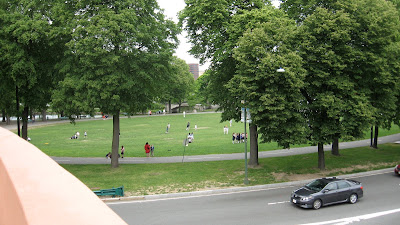
Following Seasholes text, we were required to generate impressions of Boston's Beacon Hill; currently home to high rents where vestiges of Nineteenth century Brahmin society are evident in regal masonry facades.
History tells us that everything east of Charles St. is infill land taken from the original Tri-Mountain area of which only Beacon remains. Brimmer and River Streets run parallel to Charles Street and all terminate at Beacon Street where views through the Common lead toward downtown. These streets are a canvas of period pieces that seemed to be veiled from the contemporary era by the use of park space in the Common.
Hierarchy within the city fabric is crucial for air and light, Primary streets like Beacon affront cross streets like Charles. Alleys (think Beaver Place) act as tertiary passages which allow daylight into buildings and provide good ventilation outlets.
The Charles Street Meeting House is pictured above, the carve-out establishes this corner as a dynamic node. Beyond the seating area are views to River Street.
Walking down Beaver Place toward the Fiedler footbridge and the Esplanade. This passageway enables pedestrian access to connect with the park space along the Charles River. As we approach Storrow Drive we are able to utilize the footbridge that provides continuous connection with the Esplanade. Although the Fiedler bridge gets points for creating this momentary connection, it is arguably still only a precedent for another kind of convalescence that could yield panoramic connection as the recently built Rose Kennedy Greenway is struggling to create.
Once on the Fiedler bridge we pass over Storrow Drive and are able to walk continuously without the added disturbance of waiting for traffic lights. Beyond, people use the park space for a variety of activities; the Hatch Shell is not far and ubiquitous sailors and rowers pepper the river in a good display of how our city is perpetually used.
The drawing reiterates the concept of a veiled neighborhood behind the park space of the Common, which seems to serve as a mechanism to cleanse the palette as we traverse from one district to the next. In this case, the transition area started at Park Street station in the midst of skyscrapers and high-rises before sauntering through the park toward Beacon Hill.

Importance is highlighted furthermore by the availability of the neighborhood to use the Common area and Esplanade. Different groups can feel the presence of breathing room during a typical days course; a resident walking to work can feel the diversity of varied spaces without the stuffy reality of feeling like they're living too close to their job.
The scale also seems to explode as we walk from Beacon Hill toward downtown. Within the neighborhood there's a visual perception of compression as continuous townhouses squish their faces together and seem to emphasize their vertical projection. The streets and sidewalks are small enough that walking two by two isn't easy, and then all at once we reach Beacon Street and the Park and everything opens up to reveal space and change and perceivable rescaling.


